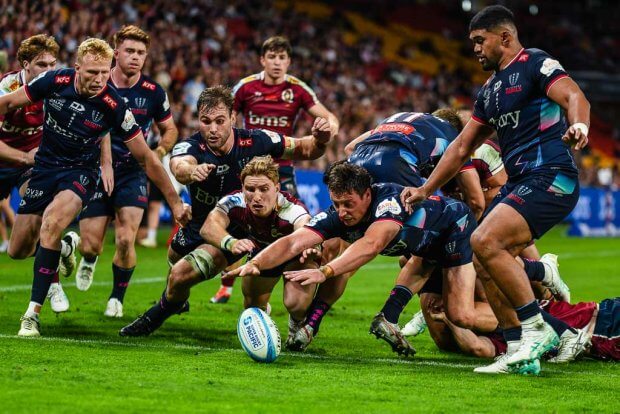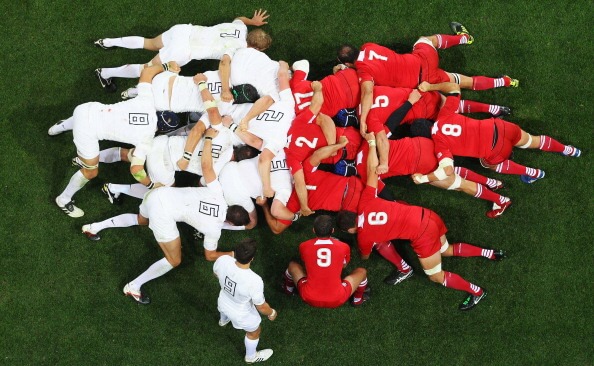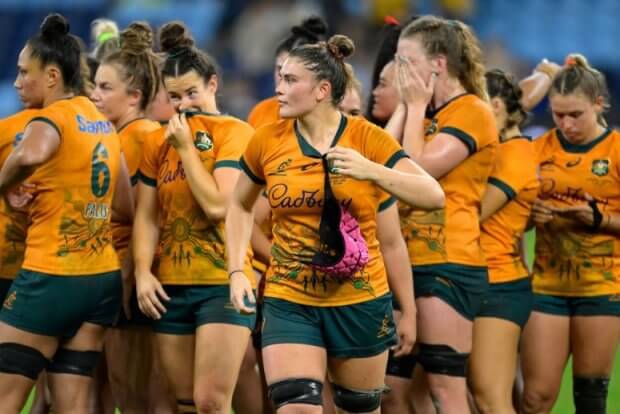With so many games it’d be easy to forget that other rugby stuff goes on. Today’s news sees Victoria look at building the base, Australian women’s 15s needing an urgent boost, more recruitment traffic heading from the Tahs, a South African drug lab (the ok kind) and some Georgian scrummaging.
Having eliminated all other options, Victorian Rugby turns to grassroots.

The Guardian reports that the game in the latte-sipping, morally-and-artistically-superior State is shifting its focus.
The closure of the Rebels this year alongside a sorry sequence of reported financial irregularities and political infighting has left local rugby in the doghouse. “The only way is up, surely,” says Rugby Victoria president Elizabeth Radcliffe.
Joe Schmidt was asked last week where Victoria’s rugby community should look to renew its energy. “Jimmy Orange has got some programs up and running in schools that are going really well,” he said. “And I think the stronger it can be through the grassroots, inevitably, you grow the interest.”
New Zealand-born Orange may sound like a vitamin C rich superhero, and his work in Melbourne public schools running programs in rugby – a sport more closely associated with private education – has gained him a not dissimilar reputation. “The talent is here but the pathway is now uncertain,” he says.
Orange’s Academy Movement program has expanded to six government schools in the past three years. He says “of course” he would love a professional team back in Melbourne, but a centralised pathway and development program across Australia is perhaps more realistic, “meaning students don’t have to leave their home state or school to get quality rugby development”.
Yet pathways need people to travel them. Rugby has recovered its Victorian club registrations to pre-Covid levels of more than 4,000, but rugby league appears to be growing locally at a faster rate. The Melbourne Storm now control Victorian juniors and reported more than 5,000 players this year. Saturday’s Wallabies crowd (21,932 packed into the on-camera eastern grandstand) was barely a quarter of the number that attended the Bledisloe Cup clash at the MCG last year, and only narrowly more than the NRL franchise’s average attendance this season, of close to 20,000.
As part of an anticipated revenue injection from the Victorian government in exchange for hosting high-profile matches in Melbourne during the 2027 men’s and 2029 women’s Rugby World Cups, he says a “step change” in funding will flow to programs in the state.
RA currently provides RV with $377,000 each year as well as additional money for high performance and as many signed Waratahs jerseys as the Mexicans want (none yet requested). That would increase under RA’s plan. Every dollar counts, after RV was dragged into the financial mire of the Rebels. The state body shared two directors with the Rebels as well as sponsors, and provided $400,000 to the embattled club in its final months, only half of which was repaid.
Super W Shake-up recommended

Brittany Mitchell of ESPN has used this column to argue for a Super W shake-up.
Despite qualifying for WXV1 and defeating France for the first time in 15 years, the Wallaroos appear to have gone backwards in 2024 despite the introduction of highly rated coach Jo Yapp.
Defeated in all three Pacific Four matches by Canada, the United States, and New Zealand respectively, the Wallaroos have already been relegated to WXV2 status for 2024 and are yet to qualify for the 2025 World Cup. But Sunday’s loss at Ballymore has further highlighted just how big the gap between Australia and the top nations remains. With top four aspirations, the global showpiece just over a year away and a home World Cup in five years, Mitchell argues that Rugby Australia must act immediately to close the gap.
The first step must be to make the Wallaroos squad full-time athletes. The growth and development of England and France over the last five years as well as New Zealand in the last two demonstrates how important having full-time athletes is to a national program. While England didn’t lift the World Cup in 2022, their incredible 30-match win streak came directly off the back of their full-time program and the strength of their national Premiership competition. Meanwhile, the Black Ferns have taken their game to another level since their program turned professional.
For several years RA has spoken of a full-time program by 2025 but as witnessed on the weekend next year is already too far away. A huge step was taken earlier this year when RA increased tier one contracts from 15 to 23 players with Australia’s best now able to earn up to $72,000 a year, but with up to 45 players in and out of the squad more needs to be done.
Next on the list must be a complete reworking of the Super Rugby Women’s competition and linking with New Zealand’s Super Rugby Aupiki. Combining both Aupiki and W has been spoken of as far back as 2022 with RA and New Zealand Rugby so far unable to reach an agreement. Several different formats have been raised, but the only way forward for the women’s game is to replicate the men’s Super Rugby Pacific competition and play a 10-team full two-round round robin competition including a full finals format. This would require expansion to five teams in New Zealand and the loss of one Australian team, retaining Drua.
Given the talent discrepancy between teams RA would be best to push open the doors to trans-Tasman talent sharing as well as the spread of Wallaroos talent among Australian sides.
A huge push must also be made by RA to bring back the many rugby players who made the change to NRL as well as bringing some of their talent to the game.
Force poach former Wallabies prop Harry Johnson-Holmes

Nine reports that the Western Force have continued their aggressive recruitment drive with the signing of former Wallabies prop and “most adult film star name in rugby” award-winner Harry Johnson-Holmes.
The 27-year-old from Cowra is capable of playing both sides of the scrum and has played 91 Super Rugby games for the NSW Waratahs since his debut in 2018. Johnson-Holmes played his one and only Test for Australia against South Africa in Johannesburg in 2019.
“I’ve been lucky enough to coach Harry through Australian under-20s as well as his first two years in Super Rugby,” Force coach Simon Cron said. “He is an extremely driven and competitive human who always has a team first mentality. At scrum time, Harry has the ability to play both sides, tight and loose, which is extremely unique* and a real skillset. We have really needed depth to give us some options in the front row. Harry is a big part of this alongside the recruitment of Nic Dolly and Brandon Paenga-Amosa as well as the return of Tom Robertson from his sabbatical at Oxford. He will add a lot of value to our team.”
Johnson-Holmes is currently recovering from his second ruptured Achilles tendon injury and hopes to return to competitive action early in the new year.
“After seven years with the Waratahs, I felt like it was time for a change of scenery. I have admired the direction the Force are taking things,” he said, with admirable restraint. “I also played alongside a lot of current Force players at the Tahs, whose feedback was really positive about the club and the direction its heading and how the environment is helping them develop as footballers.”
*We know something can’t be “extremely unique”. Take it up with the Force.
Bloemfontein drug-testing laboratory ban extended

Rugby 365 reports that the World Anti-Doping Agency has extended the suspension of Africa’s only accredited drug-testing laboratory.
In March, WADA suspended the South African Doping Control Laboratory in Bloemfontein for ‘up to six months’ – due to “multiple non-conformities” with international standards. That ban has now been extended.
“Based on the recommendation of the Laboratory Expert Advisory Group, the Chairman of the WADA Executive Committee has confirmed the extension of the Laboratory’s suspension for another six months until March 2025, or until the date that the requirements are met, if earlier. The suspension, which took effect on March 1, prohibits the Laboratory from carrying out any anti-doping activities, including analyses of urine and blood samples, except analysis related to the Athlete Biological Passport haematological module.” (Well obviously not that).
“The extension was granted based on the Laboratory’s request, which included justifications for the delay, to have sufficient time to address the issues related to the suspension.”
Disclaimer for litigious boorstids: No link between the pictured player (or any SA player/s) and the article is suggested or implied. Most of the pictures in the G&GR library are rugby players, so that’s what we often use when a story about a rugby-playing country comes up.
Georgian scrum v water cannons

The Georgians like a good scrum. Check out the video in this article.
“The police used a water cannon to push the men back, with an impact force of nine tonnes, equivalent to the weight of an elephant. The protesters didn’t disperse or run. Instead, they formed a tightly bound scrum as the water shot over their heads, shunting their bodies against the jet of water and a tall metal gate. It said everything about the Georgian ability to scrummage against the odds.”


